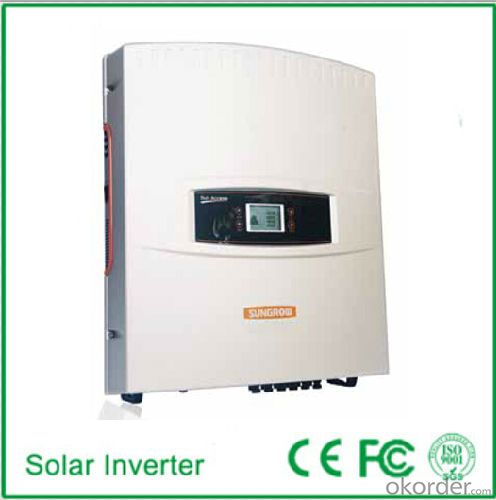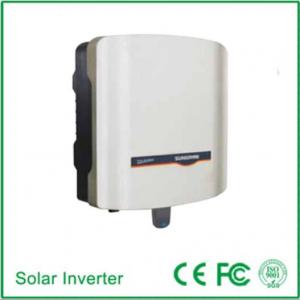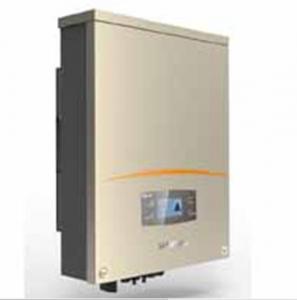Kaco Solar Inverter Photovoltaic On-Grid Connected Inverter SG20KTL
- Loading Port:
- China Main Port
- Payment Terms:
- TT or LC
- Min Order Qty:
- 500000 unit
- Supply Capability:
- 3000000 unit/month
OKorder Service Pledge
OKorder Financial Service
You Might Also Like
1. Structure of Solar Photovoltaic On-Grid Connected Inverter SG20KTL Description
A solar inverter, or PV inverter, or Solar converter, converts the variable direct current (DC) output of a photovoltaic (PV) solar panel into
autility frequency alternating current (AC) that can be fed into a commercial electrical grid or used by a local, off-grid electrical network.
It is acritical BOS–component in a photovoltaic system, allowing the use of ordinary AC-powered equipment. Solar inverters have
special functions adapted for use with photovoltaic arrays, including maximum power point tracking and anti-islanding protection.
Suitable for 50Hz/60Hz grid, could be used in Asia, Africa and Europe. Available for hand installation, no need for lifting machinery
assistance.
2. Main Features of the Photovoltaic On-Grid Connected Inverter SG20KTL
• Full 20 kW effective power at power factor of 0.9 due to apparent power reserves up to 22.2 kVA
• Photon test results "very good", with a maximum efficiency of 98% (Photon Profi 2-2012)
• Dual MPP trackers control
• Active power continuously adjustable (0~100%)
•Reactive power control with power factor 0.8 overexcited ~ 0.8 underexcited
•Includes RS-485 interface, compatible with all common monitoring systems
• Product certification: TÜV, CE, CEI 0-21, G59/2, AS4777, BDEW, VDE AR-N-4105, CGC, compliance with Italian medium voltage grid requirement
• Manufacturer certification: ISO 9001, ISO 14001, OHSAS 18000
3. Photovoltaic On-Grid Connected Inverter SG20KTL Images


4. Photovoltaic On-Grid Connected Inverter SG20KTL Specification
Input Side Data | |
Max. PV input power | 21000W(10500W/10500W) |
Max. PV input voltage | 1000V |
Startup voltage | 300V |
Nominal input voltage | 620V |
MPP voltage range | 280~950V |
MPP voltage range for nominal power | 480~800V |
No. of MPPTs | 2 |
Max. number of PV strings per MPPT | 3 |
Max. PV input current | 42A(21A/21A) |
Max. current for input connector | 12A |
Output Side Data | |
Nominal AC output power | 20000W |
Max AC output power(PF=1) | 22200W |
Max. AC output apparent power | 22200VA |
Max. AC output current | 33A |
Nominal AC voltage | 3/N/PE, 230/400Vac |
AC voltage range | 310~480Vac |
Nominal grid frequency | 50Hz/60Hz |
Grid frequency range | 47~53Hz/57~63Hz |
THD | < 3 % (Nominal power) |
DC current injection | <0.5 %In |
Power factor | >0.99@default value at nominal power |
(adj. 0.8overexcited ~0.8underexited ) | |
Protection | |
Anti-islanding protection | Yes |
LVRT | Yes |
DC reverse connection protection | Yes |
AC short circuit protection | Yes |
Leakage current protection | Yes |
DC switch | Yes |
DC fuse | No |
Overvoltage protection | Varistors |
System Data | |
Max. efficiency | 98.00% |
Max. European efficiency | 97.30% |
Isolation method | Transformerless |
Ingress protection rating | IP65 |
Night power consumption | <1W |
Operating ambient temperature range | -25~60℃(>45℃ derating) |
Allowable relative humidity range | 0~100% |
Cooling method | Smart forced air cooling |
Max. operating altitude | 4000m (>3000m derating) |
Display | Graphic LCD |
Communication | RS485(RJ45 connector) |
DC connection type | MC4 |
AC connection type | Plug and play connector |
Certification | EN62109-1, EN62109-2, EN61000-6-2,EN61000-6-3, VDE0126-1-1, |
CEI 0-21, AS/NZS3100, AS4777.2, AS4777.3, | |
VDE-AR-N-4105, BDEW, CGC | |
Mechanical Data | |
Dimensions(W×H×D) | 648×686×246mm |
Mounting method | Wall bracket |
Weight | 55kg |
5. FAQ of Photovoltaic On-Grid Connected Inverter SG20KTL
Q1. What is the difference between inverter and solar inverter?
A1. Inverter only has AC inpput, but solar inverter both connect to AC input and solar panel, it saves more power.
Q2. What is the difference between MPPT&PWM?
A2. MPPT has higher efficiency, it can track the max power point and won't waste energy.
- Q: What is the role of a solar inverter in a solar-powered water purification system?
- The role of a solar inverter in a solar-powered water purification system is to convert the direct current (DC) electricity generated by the solar panels into alternating current (AC) electricity, which is then used to power the water purification system. The solar inverter ensures that the electricity produced by the solar panels is compatible with the electrical requirements of the water purification system, allowing it to function efficiently.
- Q: Can a solar inverter be used with a remote monitoring system?
- Yes, a solar inverter can be used with a remote monitoring system. Remote monitoring systems are designed to monitor and control the performance of solar inverters from a remote location. This allows users to track and analyze the solar energy production, detect any issues or faults in the inverter, and make necessary adjustments for optimal performance.
- Q: Can a solar inverter be used with solar-powered streetlights?
- Yes, a solar inverter can be used with solar-powered streetlights. A solar inverter is responsible for converting the direct current (DC) produced by solar panels into alternating current (AC) that can be used to power various electrical devices, including streetlights. By integrating a solar inverter into the system, solar-powered streetlights can efficiently utilize the energy captured from the sun to illuminate the streets.
- Q: How does a solar inverter handle voltage fluctuations from the solar panels?
- A solar inverter handles voltage fluctuations from the solar panels by continuously monitoring the incoming voltage and adjusting its own output voltage accordingly. It employs a control mechanism that stabilizes the voltage to ensure compatibility with the utility grid or the connected appliances. This enables the solar inverter to efficiently convert the variable DC voltage from the solar panels into a stable AC voltage, maintaining a consistent and reliable power supply.
- Q: How long does it take to install a solar inverter?
- The time it takes to install a solar inverter can vary depending on various factors such as the complexity of the installation, the size of the system, and the experience of the installer. On average, it typically takes a few hours to a full day to complete the installation process.
- Q: What are the signs of a faulty solar inverter?
- Some signs of a faulty solar inverter include a sudden decrease in energy production, frequent system shutdowns or restarts, unusual noises coming from the inverter, error messages or warning lights displayed on the inverter, and a lack of communication between the inverter and monitoring devices.
- Q: Can a solar inverter be used with different types of tracking algorithms?
- Yes, a solar inverter can generally be used with different types of tracking algorithms. Solar inverters are designed to convert the direct current (DC) generated by solar panels into alternating current (AC) for use in homes or businesses. The tracking algorithms, such as single-axis or dual-axis tracking, are responsible for optimizing the output of solar panels by adjusting their tilt and orientation according to the sun's position. Solar inverters are typically compatible with various tracking algorithms, allowing flexibility in system design and maximizing energy generation.
- Q: What is the maximum DC input current that a solar inverter can handle?
- The maximum DC input current that a solar inverter can handle varies depending on the specific model and capacity of the inverter. It is typically mentioned in the product specifications and can range from a few amps to several hundred amps.
- Q: How does a solar inverter communicate with monitoring systems?
- A solar inverter communicates with monitoring systems through various means such as wireless technologies like Wi-Fi, Bluetooth, or Zigbee, or through wired connections like Ethernet or RS485. These communication channels allow the inverter to transmit important data and performance metrics to the monitoring systems in real-time.
- Q: How does a solar inverter affect the overall system reliability?
- A solar inverter plays a crucial role in the overall system reliability of a solar power system. It converts the direct current (DC) generated by solar panels into alternating current (AC) that can be used to power homes or be fed back into the grid. By ensuring efficient and reliable conversion, a solar inverter helps optimize the system's performance and stability. It also incorporates various protection features like over-voltage and over-current protection to safeguard the system from potential damage. Therefore, a high-quality and well-maintained solar inverter positively impacts the overall reliability of the solar power system.
Send your message to us
Kaco Solar Inverter Photovoltaic On-Grid Connected Inverter SG20KTL
- Loading Port:
- China Main Port
- Payment Terms:
- TT or LC
- Min Order Qty:
- 500000 unit
- Supply Capability:
- 3000000 unit/month
OKorder Service Pledge
OKorder Financial Service
Similar products
Hot products
Hot Searches
Related keywords


























